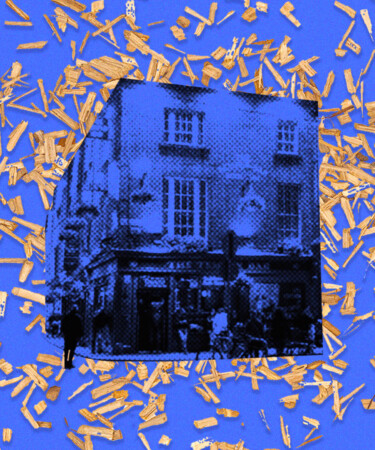If you’ve ever wandered into an old-school pub, you may have encountered sawdust strewn haphazardly across the joint’s wooden floors. Some might see it as a cool detail, and others as an old-timey gimmick or puzzling eyesore. But what looks like the aftermath of a mid-shift carpentry project is, in fact, an old tradition born out of necessity and kept alive for nostalgia’s sake.
Dusty Origins
It’s unclear where the phenomenon first took hold, but it’s likely that it was either in Spain or Mexico. The people of Asturias, an autonomous community in northern Spain, have long practiced a tradition called escanciado, or pouring cider into a serving glass from a distance to mimic how cider used to shoot out when tapping old chestnut barrels, aerating mid-air on its way into a glass. Due to the high risk of spillage during escanciado, many siderias (or cider bars) in the region would spread sawdust across their floors to absorb spills. Mexico’s pulquerias have also historically used sawdust for similar purposes; the long tradition of pulque-drinking can involve spilling the first sip of a session as a donation to Mother Earth.
The practice of laying down sawdust in bars and restaurants as we know, though, is believed to have trickled over from the U.K. In the late 1800s, American bars, cheap restaurants, and butcher shops implemented daily sawdusting of their floors to soak up spilled drinks, blood, or any other liquid that could cause patrons to slip and fall. Some historic bars, like McSorley’s Old Ale House in New York City, claim that the tradition was adopted to clean up customers’ spit and chewing tobacco remnants that would inevitably end up on the floor. This would explain why “spit and sawdust” is now a British slang term used to describe a particularly dive-y pub.
Sawdusting Stateside
While it may seem messier than other sanitary measures, sawdusting became common before the American iron and steel boom, as woodworking was more commonplace than it is today. In the 1880s, New York even had sawdust dealers that would make daily rounds to their clients, selling 25-cent barrels of the stuff. To the credit of these establishments, sawdust can absorb almost any liquid, and according to Florida-based wood-processing company GI Shavings LLC, its compounds can deodorize minor smells. Plus, sawdust clumps up easily when swept and is heavy enough that it won’t puff up into the air when disturbed.
In spite of these benefits, by the early 1900s, a restaurant era of polished white tile floors and bright lighting had arrived. Health inspectors got wise to the fact that some business owners weren’t sweeping their sawdust regularly, and many cities passed ordinances outlawing the cleaning method. Some laws had exceptions for butcher shops provided they swept daily, but the custom largely fell out of fashion.
To Dust We Shall Return
The 1930s and the repeal of Prohibition saw a slight return of sawdusted floors, mainly at steakhouses, pubs, and, later, barbecue joints. At that point, though, they were closer to nostalgic decorations than staples of bar upkeep. Over the decades, some establishments have held onto the practice and made it a part of their allure — and a functional novelty. McSorley’s has been around since 1854, and it still proudly throws down fresh sawdust daily. Another Manhattan Irish bar, The Dead Rabbit, has only been open since 2013 but has implemented the practice as a nod to pubs past.
“It was traditionally used in the New York Irish waterfront bars, where the sawdust soaked up whatever got spilled,” the bar explained in a 2018 Facebook post. “It also made it easier to slide a keg, beer box or unconscious customer across the floor. See? Totally practical.”
So, if you find yourself standing on a mound of sawdust in a dimly lit taproom with a pint in hand, spill out a sip or two for a tradition’s sake.
*Image retrieved from The Dead Rabbit on Instagram
